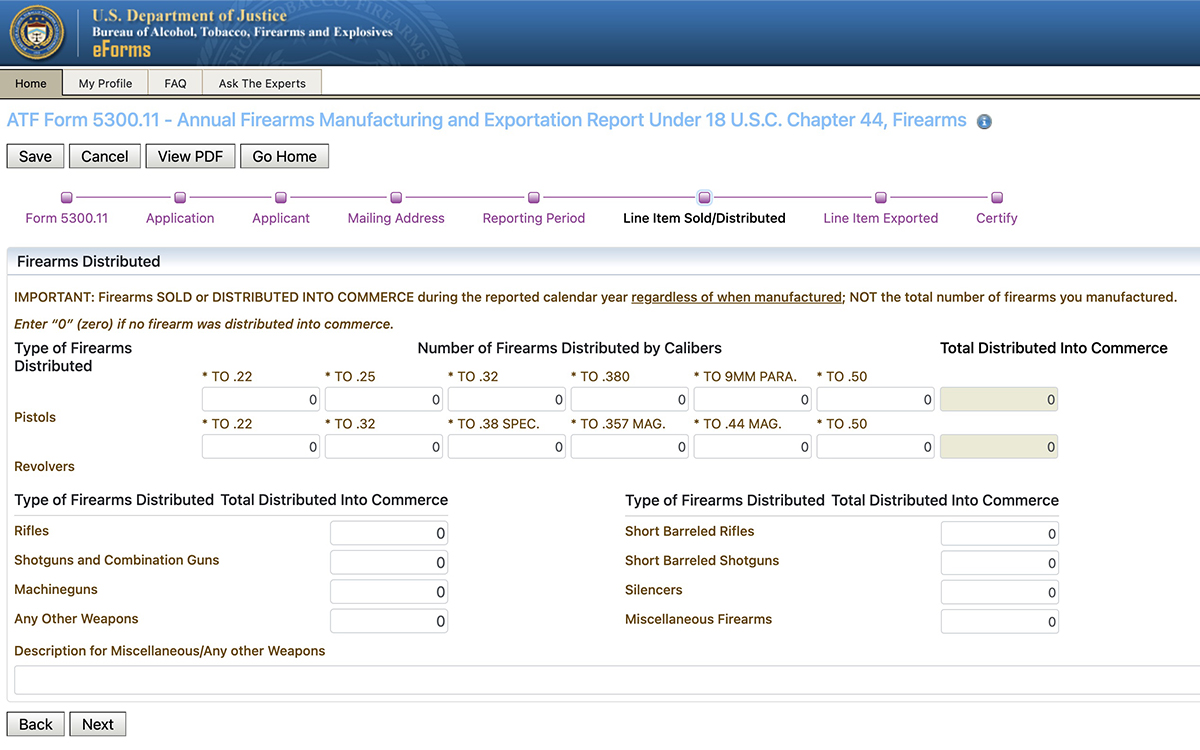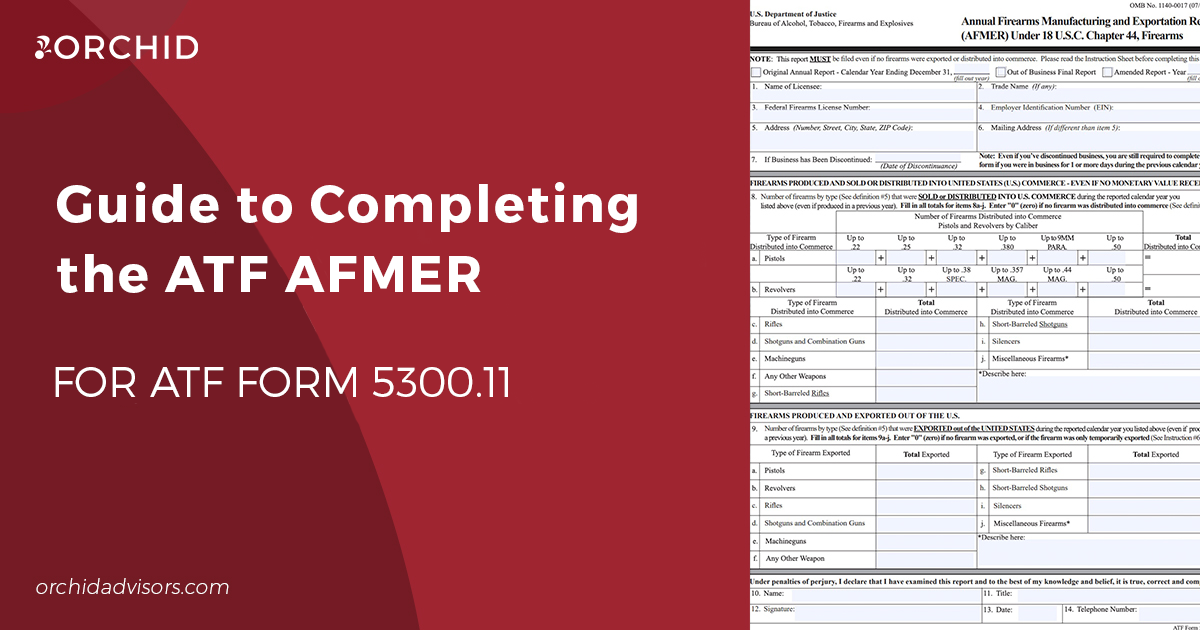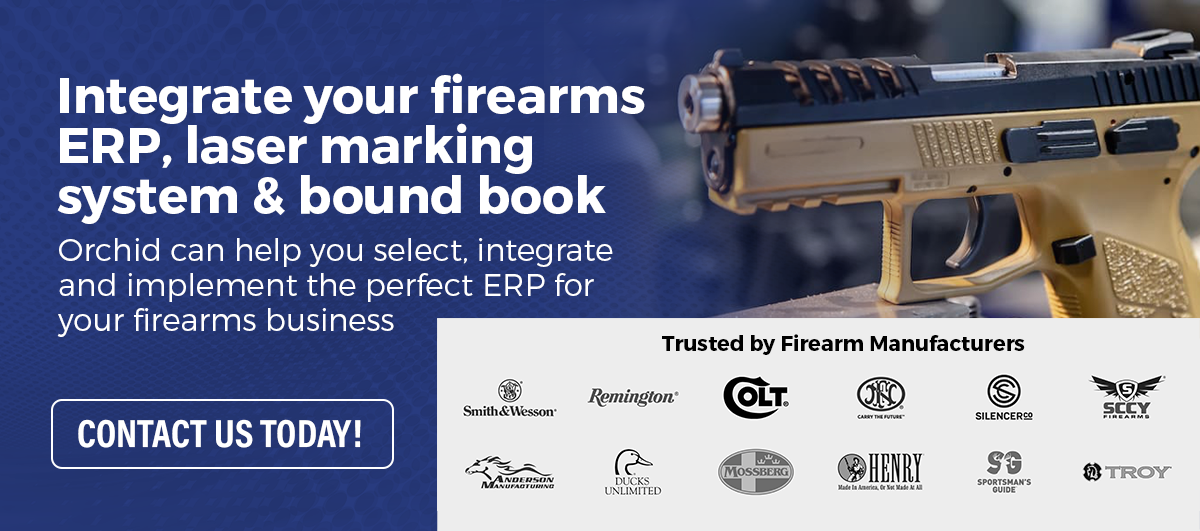A provision of the Gun Control Act (GCA), all federally licensed firearm and destructive device manufacturers (Type 07 and 10 FFLs) are to submit an annual production report of manufacturing and export activity to ATF. Completed using ATF Form 5300.11, industry data from the previous calendar year is collected by April 1, compiled, and published in the Annual Firearms Manufacturing and Exportation Report (AFMER) by the ATF.
Included in the AFMER is a summary of total industry production and a breakdown of manufacturing and export data by individual manufacturer. This data is then further broken down by firearm type (Pistol, Revolver, Rifle, Shotgun, and Miscellaneous Firearm) and caliber groupings for pistols and revolvers distributed for commerce.
In the following sections, we cover essential information on ATF AFMER and provide instructions on how to complete ATF Form 5300.11.
Table of Contents
Must-Know Information
– Deadlines and Timelines
– Completion and Submission
– Firearm Reporting
How to Complete Form 5300.11
ATF AFMER Assistance
ATF AFMER Must-Know Information
Deadlines and Timelines
The ATF AFMER reflects production data for a given calendar year, extending January 1–December 31.
ATF sends an AFMER filing notice to all licensed manufacturers in mid-February or early March to collect data from the previous year (i.e., if the notice is received in February 2024, ATF is requesting data from 2023). Manufacturers then have until April 1 of that year to complete and submit their annual report.
Though manufacturers may submit their Form 5300.11 before receiving notice from ATF and the April 1 deadline, FFLs are not permitted to file before the calendar year ends – unless the business has been permanently discontinued. Completed AFMERs must be filed within 30 days following discontinuance of business.
ATF Notice: February/March
Submission Deadline: April
Completion and Submission
ATF Form 5300.11 must be submitted annually by all Type 07 (manufacturer of firearms) and Type 10 (manufacturer of destructive devices) FFLs. The report must be completed and signed/certified by an individual authorized by the FFL (i.e., Responsible Person) to sign/certify and be responsible for the completeness and accuracy of the information submitted.
FFLs may complete Form 5300.11 by using the form mailed by ATF, downloading and printing the digital PDF form on ATF’s website, or accessing an electronic application on the ATF eForms platform.
Completed forms must be submitted by April 1 and are only accepted in two formats: (1) electronically via eForms; or (2) physically mailed to the address below. Email submission is not accepted.
Mailing Address
ATF–FFLC
AFMER Program
244 Needy Roa
Martinsburg, WV 25405
Should an FFL discover a reporting error after submission, licensees may send ATF an amended AFMER, either with the words “Amended Report” written across the top or “Amended Report” checked during the Reporting Period steps of the eForms application. Be sure to note the appropriate year of the amended report.
Only those filing AFMER reports using the eForms platform will have access to their reports after submission.
2023 ATF AFMER DEADLINE
Day(s)
:
Hour(s)
:
Minute(s)
:
Second(s)
Firearm Reporting
All firearms produced and sold or distributed into commerce or exported by manufacturers during the previous calendar year ending December 31 should be reported in the AFMER, regardless of when they were manufactured and if monetary value was received.
Firearm types to report:
- Pistols
- Revolvers
- Rifles
- Shotguns/Combination Guns
- Machineguns
- Any Other Weapons (AOW)
- Short-Barreled Rifles (SBR)
- Short-Barreled Shotguns (SBS)
- Silencers
- Miscellaneous Firearms (e.g., frames or receivers)
Firearms not to report:
- Firearms manufactured but still in your possession (i.e., not distributed into commerce or exported)
- Firearms distributed to another licensed manufacturer for further manufacturing (including manufacturers contracted by approved marking variance, and after completion return the firearm back to the original manufacturer)
- Firearms received solely for the purpose of the manufacturer to act as a Dealer, thus, only receiving for purposes of transferring.
- Firearms remanufactured/customized that were previously in the possession of a non-manufacturer
- Firearms incorporating frames or receivers of foreign manufacture
- Firearms produced solely for the official use of U.S. Armed Forces
- Destructive devices, as defined
- Antique firearms, as defined
- Firearms exported temporarily under an approved DSP-73 application
Because a lack of production activity is just as important as commerce/export activity, FFLs who don’t manufacture any firearms in the reporting year, must still file an AFMER and would mark/enter zero (“0”) when completing their AFMER form.

How to Complete ATF AFMER
Form Sections/Steps
The paper/digital PDF version of the ATF Form 5300.11 (AFMER) is broken into four sections:
- Reporting Period & Licensee Information
- Firearms Produced and Sold/Distributed
- Firearms Produced and Exported
- Certification
Reporting Period & Licensee Information
The first AFMER section asks for the type of report being submitted, the calendar year being reported, and licensee contact information, including license name and FFL number, and addresses. eForms also asks for the phone number and email of the user completing the report during this step.
Firearms Produced and Sold/Distributed
The first of two firearm reporting sections, FFLs are to note the number of firearms, by type (and caliber, when applicable), that were sold or distributed into U.S. commerce during the reported calendar year, even if produced in a previous year.
Handguns are divided into Pistols and Revolvers, each with six caliber sub-ranges. For more information on these groupings and common calibers within each, view our ATF AFMER Pistol and Revolver Caliber Groupings guide. The six groups are then totaled up for both firearm types.
Next, FFLs report totals for Rifles, Shotguns/Combination Guns, Machineguns, Any Other Weapons (AOW), Short-Barreled Rifles (SBR), Short-Barreled Shotguns (SBS), Silencers, and Miscellaneous Firearms – no caliber breakdown required. However, a short description of Miscellaneous Firearms must be included on and/or attached to the submitted form.
If no firearm was distributed into commerce, mark/enter zero (“0”).
Firearms Produced and Exported
Similar to the previous section, FFLs are to report the number of firearms, by type, manufactured and exported out of the U.S. during the reported calendar year, even if produced in a previous year.
Totals for Pistols, Revolvers, Rifles, Shotguns/Combination Guns, Machineguns, Any Other Weapons (AOW), Short-Barreled Rifles (SBR), Short-Barreled Shotguns (SBS), Silencers, and Miscellaneous Firearms should be reported with no caliber breakdown required of any firearm type. A short description of Miscellaneous Firearms must be included on and/or attached to the submitted form.
If no firearm was exported, or if the firearm was only temporarily exported, mark/enter zero (“0”).
Certification
The last section of the AFMER asks the FFL representative/RP submitting the form to declare that the report was examined and all information is true, correct and complete to the best knowledge and belief of the individual. The user will then physically or electronically sign the form.
ATF AFMER Assistance
Whether you manufacture 100, 100,000, or 1 million guns a year, the right technology can make tracking firearm production and completing the ATF AFMER easy.
At Orchid, our industry-leading electronic Bound Book solution and ERP integrations enable FFLs to automate operations, eliminate manual dual data entry, audit serial numbers efficiently, track inventory, and maintain accurate and compliant regulated records needed to report firearm production and exportation data. Implementation is simple and API connections can be made for NetSuite, Epicor, Fishbowl and other popular ERP systems. Plus, backed by in-house legal and compliance professionals, our software is trusted by the biggest firearm manufacturers in the U.S.
Contact us today to learn how your FFL can benefit from Orchid’s software manufacturing solutions.
For questions regarding completion of ATF Form 5300.11 (paper or eForm), contact the ATF Federal Firearms Licensing Center (FFLC) at (866) 662-2750 or eforms.admin@atf.gov.








0 Comments